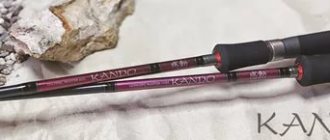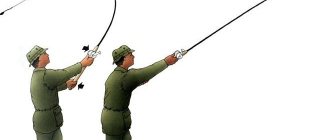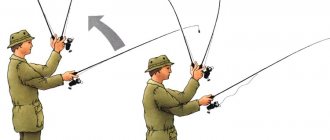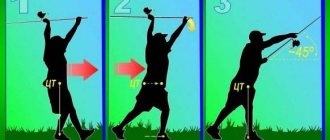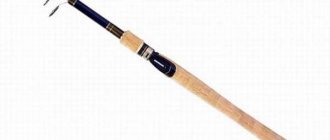There are many factors that influence the choice of gear in specific conditions. Choosing which spinning rods are best for long-distance casting takes into account the length, test, fishing location, formation, type of guide rings, etc. Typically, a coastal spinning rod is used for long-distance casting, which helps to catch distant, promising areas for fish. When fishing from a boat, it is not advisable to use long-range gear, since it is possible to take any comfortable position at a distance of up to 30 m from the fishing spot.
When is long casting necessary?
Content
During coastal fishing, the angler is very limited and does not have the opportunity to fish at a great distance from the shore. Even a spinning rod is not capable of providing sufficient range if the rod is chosen incorrectly. When fishing from the shore, the fisherman is deprived of the mobility of movement around the reservoir. With classic gear, you can cast up to 40-50 m, and only if you have a sufficient level of skill and an average rod length.
Spinning rods are useful for long-distance casting from the shore on both small and large rivers.
Spinning for long-distance casting from the shore is useful on both small and large rivers. On streams and rivers with a small channel width, long-range spinning rods allow you to catch fish from the opposite bank. The tactic is especially effective when hunting for cautious fish or when there is no way to get to the shore from the other side. In large reservoirs, trophy individuals are located at a great distance, and deep-sea predators also live closer to the middle of the channel.
In half of the cases of fishing on large rivers, the promising place is located at a distance of 70, 100 or 120 m. It is impossible to cast bait at such a distance unless you use the right spinning rod.
A spinning rod with a float for long-distance casting is designed for fishing:
- channel edges;
- deep-sea pits;
- dumps and rifts at great depths;
- long ditches;
- flooded trees carried far from the shore or specially brought in the middle of the riverbed.
In such conditions, long-casting tackle is critical to fishing success. Without the right choice of fishing rod, you will have to be content with rare bites of small fish close to the shore. There is no need to talk about trophy fishing near the shore, except during the pre-spawning feast, when the fish are not so picky and swim to the shore in search of spawning grounds.
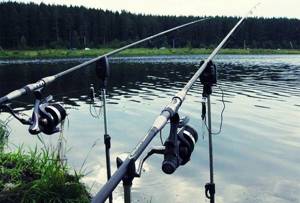
You will have to be content with rare bites close to the shore without the right choice of fishing rod
The need for long casting and promising places
Of course, the determining factor when choosing a spinning rod for long-distance casting is the size of the reservoir or the ability to swim to the desired point. So, for example, when fishing on small rivers, the tackle should be as light and compact as possible, since in addition to the need to cast no further than 50 meters, you often have to overcome various kinds of obstacles - bushes, snags, fords, etc. The same can be said and about fishing from a boat. When on board a small vessel, you need a short rod, since the criterion of range simply disappears; you can reach any point in the reservoir. Moreover, if fishing is carried out by two or more people, a strong swing becomes simply dangerous.
So, the main method when it is necessary to use a fly rod is fishing from the shore in large bodies of water. Here we are talking about cases when the bait needs to be delivered more than 100 meters in order to explore promising places. It is worth giving an example of promising places where traditional predators like to ambush.
Edges in the bed of a reservoir
On large, deep rivers it is necessary to carefully monitor the main stream. Where the reverse current is very noticeable or where its gradient is too great in a forward flow, there are always so-called edges, places behind which a predator, such as a pike or perch, loves to hide. Also, for example, in northern lakes, to find fish you need to know the bottom topography well, since it is impossible to visually determine where the edge is. However, this work is almost always rewarded by the capture of a valuable trophy - grayling, brown trout or whitefish.
Riffles at depth and drops behind them
These are very promising places, typical of large rivers. They always contain a lot of fish, and each region has its own species, the most valuable of which is the salmon family, which often makes a hunting refuge in such areas. This is not surprising, since riffles always supply the predator with stunned small fish or insects. However, fishing in such a place is very difficult and often requires not only long casting, but also the ability to fish “wading”, located either upstream from the riffle, or beyond the end of the drop.
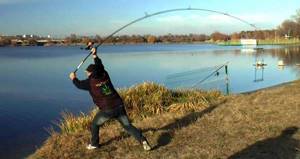
Sudden changes in depth and long crevices
They are also very promising places, allowing the predator to hide from the field of view of the prey and suddenly attack it if necessary. The search for these features on rivers has already been mentioned when talking about edges. To find holes in reservoirs with standing water, it is necessary to examine the bottom topography; if fishing is done from the shore, this can be done using jig gear. The advice to seek help from local fishermen who know all the secrets and features of the reservoir never ceases to be relevant. They, of course, will not reveal them, but they will still be able to obtain partial information, and that is already something.
"Slough" or extensive snags
A classic place to ambush pike, burbot or catfish. At a long distance, such objects are characteristic of reservoirs artificially created by blocking the river bed with a dam and subsequent flooding of a forested area. Very interesting objects where, when fishing from the shore, a long cast is simply necessary, since the fish are dispersed throughout the entire area of the reservoir. Also, in addition to the fishing rod, it is necessary to correctly select equipment and fishing techniques, since if mistakes are made, frequent snags cannot be avoided.
As can be seen from the above points, casting range is one of the decisive factors for achieving successful fishing from the shore on a large body of water. If the characteristics of the spinning rod blank do not meet the requirements of the water area being studied, then the chances of a successful fishing outcome will tend to zero.
An example of a cautious fish that requires a long cast to catch from the shore is the asp. It hunts in the upper layers of water and therefore perfectly notices the fisherman, while moving as far away from him as possible. Accordingly, the outcome will be positive only if the gear is selected correctly.
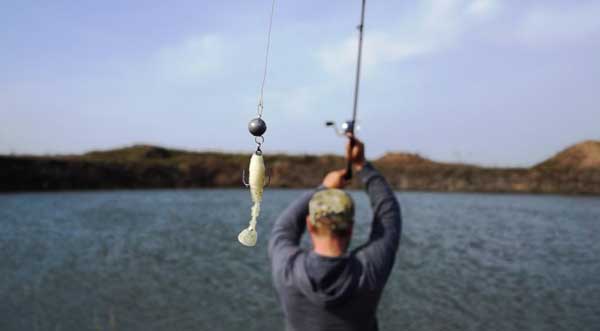
Characteristics and features of long-range spinning rods
To determine which spinning rod is best suited for long-distance casting, it is important to take into account the basic characteristics of the gear. All elements of the gear must be harmoniously combined and improve each other’s long-range parameters.
The important elements are:
- coil;
- correct fishing line;
- suitable test form;
- type of bait;
- equipment, etc.
Read more
How to make spinning moves correctly?
The key element is the spinning rod; it has the greatest importance in casting distance.
Many anglers give their own advice on how to choose a spinning rod for a beginner, based on experience. Most fishermen agree that the choice of spinning rods should be made based on fishing technique and the characteristics of the spinning rod.
Main characteristics and description of spinning rod for long casting:
- The length of the spinning rod for long casting has the greatest influence on casting. As the length of the rod increases, long-range characteristics increase, the casting process becomes more complicated and the number of suitable places narrows;
- build. The correct action gives the necessary rigidity to the rod and allows you to deliver the bait as far as possible;
- type of pass rings. With low-quality and narrow guides, the possible casting distance is reduced by 20-50%.
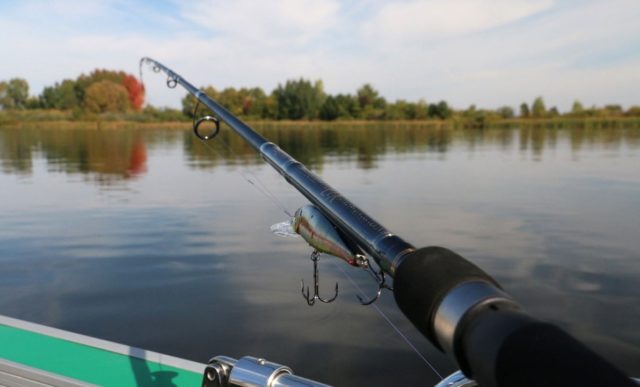
Spinning rod has the greatest importance in casting distance
Many manufacturers have a whole series of sea fishing rods in their assortment, designed for long-distance fishing. Marine spinning rods for long-distance casting are more expensive than the classic versions, but they are more durable and can easily handle fish weighing 10-30 kg or more.
Criteria for choosing a long-range spinning rod
As when choosing any other fishing rod, you need to pay attention to the main parameters that depend on the intended type of fishing and type of fish, and determine the accuracy and casting range. These characteristics include:
- the length of the blank, on which the swing properties of the rod and the flight range of the bait generally depend;
- action, a very important parameter that allows you to select a rod for a specific type of fishing and on which depends how well the wiring will be felt, as well as the notching;
- the material of the rings and their configuration are very important elements of the spinning blank, since they determine how long the fishing line will last, as well as the extent to which the load will be evenly distributed along the rod;
- The rod test tells you how much bait can be used for effective and, importantly, safe casting.
Any mistake in the selection of these characteristics will inevitably lead to a negative result or, even worse, to negative consequences. Thus, an incorrectly selected length will not allow you to cast the required distance or will provide constant hooks on coastal bushes. An incorrect structure will not allow the bait to be given the necessary plausibility of the game that will seduce the predator; rather, it will detect the deception and move even further from the shore.
Recommended reading: Winter tips
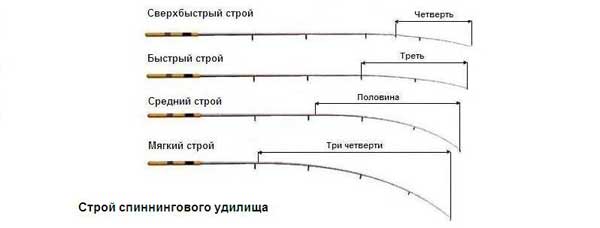
The quality of the rings will affect the wear of the cord, which at one point will lead to its breakage during casting or retrieving, providing the angler with the loss of both the bait and the trophy. Since the rod is still a fly tool, the test must be selected with a tolerance from the specified interval, usually this is plus three grams from the lower limit and minus 3 grams from the upper limit. Thus, the 7-21 gram test is optimal for casting baits weighing 10-18 grams.
It can be seen that the distinctive feature that makes the main contribution to the casting distance is the length of the blank. This is explained by the fact that the moment and the force transmitted to the cast, and, consequently, the impulse of the bait are directly proportional to the length of the arm. It is classically believed that long-range fishing rods have a length of over 3 meters, but both the structure and the skills of the fisherman contribute here, so there are cases when spinning rods of 2.7 meters showed the best result in terms of bait delivery range.
One feature that should be mentioned here is the uncertainty in the choice of form structure. The longest cast can be made using a slow, parabolic action, in which the entire length of the rod is working. However, such a system responds very “sluggishly” to bites and is uninformative when guiding, not allowing you to achieve the desired game.
Therefore, anglers prefer medium or fast-medium action, which provides good hooking and sensitivity, although it requires certain skills to ensure long casting.
To summarize, we can say that before choosing a spinning rod for long-distance casting from the shore, you need to carefully familiarize yourself with the features of the reservoir, its topography and coastline. As well as the habits and type of intended prey, on which the choice of catchable bait and, consequently, the parameters of the fishing rod used depend.
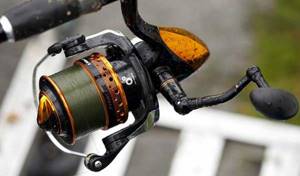
Spinning rod structure
The structure of a spinning rod for long-distance casting is an important characteristic; it is one of the first to be taken into account.
Depending on the action, fishing rods are divided into 3 main classes:
- fast action - these are peculiar whips that bend strongly under load, but only at the tops;
- medium action causes the rod to bend from the middle of the stick;
- a slow action causes the entire rod to bend.
Now a natural question arises: “Which of them has a better effect on flight range?” Professionals and any fishermen with experience note that the best rods are those with a slow action; with them you can cast the equipment the farthest. Due to the ability to bend along the entire length, they give more inertia to the bait, working on the principle of a spring. The main disadvantage is the lack of sensitivity; the fisherman will not be able to perform the hook in a timely and quick manner. Not always good, but slow action requires a greater range of motion.
Medium action rods, which allow long casts of 100 meters or more, require the fisherman to have sufficient experience. As the casting distance increases, the technique becomes more complex. Despite the greater difficulty in handling, they make it easier to perform a quick jerk with a fishing rod.

An important characteristic is the structure of the spinning rod for long casting
The fast action model, which allows you to throw the bait far away, is a professional rod, since it will be difficult for a beginner to master the throw. The rods are quite rigid and do not create the necessary inertia; only many years of training will help you cast the bait in the right direction, at the desired distance and to a suitable point. The main advantage of such “sticks” is high sensitivity and fast hooking.
Main models
1. Raffer Carp long casting rod: medium action carp rod made of composite material. Large-diameter guides on reinforced legs, which facilitate unhindered casting over long distances. Length – 3 m, consists of 2 sections, weight – 421 g, test reaches 120 g.
2. Kudos Baltazar carp rod: durable carbon rod with medium action. Length is 3.6 m, weight – 290 g, consists of 5 knees, bait test – 120 g.
3. Grays Ivory carp rod: made of carbon. Consists of 2 elbows, length – 3.96 m, weight – 340 g. Equipped with an open reel seat, reinforced rings on the legs. The maximum test reaches 150 g.
4. Daiwa long-distance casting rod: balanced and flexible, designed to withstand significant loads. Made from high modulus graphite. Length – 3.6 m, bait test reaches 120 g.
5. Fox Horizon Long Casting Rod: A durable carbon rod that delivers precise casting. Consists of 2 elbows, length – 3.65 m, weight – 271 g, maximum bait test – 120 g.
6. Salmo Blaster carp rod: a reliable and durable rod made of composite material. Consists of 2 sections, length – 3.3 m, weight – 390 g, action – medium.
7. SHIMANO carp rod: designed for the longest casts. Made of carbon fiber, equipped with 6 durable guide rings. Length - 3.96 m, weight - 398 g, consists of 2 sections, maximum test - 120 g.
8. Kosadaka long casting rod: telescopic carp rod, consists of 7 sections, length – 3.9 m, weight – 409 g, made of carbon.
9. Flagman long casting rod: a carbon carp rod that is suitable for beginner fishermen. Consists of 3 sections, length – 3.9 m, weight – 466 g, handle made of porous non-slip material.
10. Rod for long-distance casting Major Craft: is a spinning rod, length – 2.74 m, action – medium, consists of 2 legs, weight – 155 g. It is distinguished by its power and affordable price.
Spinning rod length
The length of the rod is one of the key parameters. Only a long spinning rod will help you make a long cast; with a 2-2.5 m rod you won’t be able to deliver the bait further than 50 m. Long poles provide the possibility of a long swing and increased casting distance by inertial force. The minimum length of a spinning rod for long-distance casting starts from 2.7 m. With such a spinning rod, if you have the skills, you can cast bait at 80-100 m. On rivers with a medium-sized bed, on lakes, in creeks, etc., the distance is enough to catch most places
Read more
Spinning fishing for beginners
The length of the spinning rod for long casting varies depending on the type of reservoir:
- Mostly, plug rods with at least 3 elbows are used as long-range spinning rods. The optimal length is 2.7-3.2 m, they are sufficient for most conditions: any lakes, rivers and reservoirs;
- Even longer rods are used when fishing at sea, their length sometimes reaches 4.2 m. Fishing on lakes does not require such a length of rods. Larger models weigh more and are less maneuverable.
Medium action
Among anglers, the average action of a spinning rod is often called the “golden mean”. Therefore, if you are a beginner and are just starting to understand all the intricacies of spinning fishing, it is better to choose this option. This stiffness class is characterized by versatility and is suitable for most conditions.
Spinning rods with medium action (Medium/Moderate) bend 2/3 of their own length. They are effective when fishing on large rivers or lakes from the shore, where you need to make long casts of bait and control them. Elite models have excellent sensitivity, which is important when fishing using the jig method.
A blank with a medium degree of hardness is suitable for fishing using oscillating and rotating spoons, crankbaits and deep wobblers. It can be used in still water or with a slight current. Some fishermen use spinning rods with medium action in twitching, making elegant movements with minnow wobblers.
Passing rings
The internal diameter of the rings, their quantity, location and quality are of significant importance. The main task of the guides comes down to guiding, aligning and holding the fishing line. In order for the fishing line to fly the greatest distance, the rings should not create unnecessary friction, so the inner surface should be smooth. Despite the imaginary insignificance of the moment, this has a significant impact on the range of the tackle. If the fishing line rubs against the rough surface of 7-9 guide rings, the casting distance will be reduced by half. Minimal resistance is the key to a long throw.
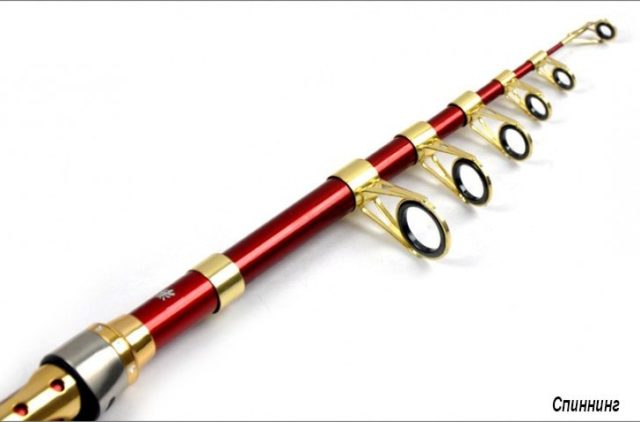
For long casting, the placement of rings on a spinning rod is important.
The placement of the rings on a spinning rod for long-distance casting is also important; they must be strictly in line, without any displacement. If the rings have moved off the axis, excess resistance appears.
What are the best criteria for choosing rings?
- large diameter. The largest rings are located at the base of the handle, not far from the reel;
- internal inserts. You should pay attention to the material; it should be smooth and strong enough. The best are titanium and carbon inserts;
- fastening quality. The rings and the blank must be inseparable; displacement will lead to difficulties in casting and the need for repeated casts;
- number of rings. It is best to avoid models with an excessive number of guides, but there should be enough of them so that the line is evenly distributed over the blank and does not create unnecessary stress on the top.
Tips and recommendations for choosing spinning rods for long casts
Not all the rules on how to choose a spinning rod for long-distance casting are listed. It is worth paying attention to:
- rod test. Spinning rods for beginners are usually taken heavy or extra heavy, since beginners tend to use baits that are too heavy to make throwing easier. In general, professionals take rods from the middle class, designated in the markings by the letter M. Average test - 10-28 g;
- type of bait. The best for long-distance casting are jig heads and spoons. Despite their small dimensions they have significant weight. Light wobblers, balancers, etc. cannot be delivered too far; we can take the length of the fishing rod somewhat shorter, as a test;
- type of suitable coil. Most models are adapted for various types of coils. If the spinning rod is in the hands of a beginner, it is better to use a spinning reel, but for an experienced fisherman, the multiplier will show the best characteristics.
Read more
Jig fishing for beginners

It takes dozens of casts to practice the correct technique.
Long casting technique
Many fishermen do not know how to make a long cast with a spinning rod after the first unsuccessful attempts, although at first glance everything seems simple. The correct technique has to be practiced over dozens of casts. Almost every fisherman is capable of delivering bait to 60-80 m after a short training. Spinners with experience and skills are able to deliver bait over a distance of 100 m or more.
How to make a long cast with a spinning rod:
- Throwing tactics from behind. It is better to throw forcefully over your head. We hold the line handle, gradually lowering the bait by 30-70% of the length of the “stick” and press the line with our finger. We move the spinning rod behind our back and send the bait in the desired direction. When the peak height is reached, but before the line begins to tighten, we release the finger.
- Through the side. The technique is used in conditions where overhanging trees do not allow you to throw the bait over your back. The movements are similar, but the cast has to be done with a swinging movement from the side.
Some rules:
- It is better to hold the rod with both hands to give maximum acceleration;
- It is better to lower the fishing line by 1/2 or 2/3 of the length of the fishing rod;
- The angle of movement of the bait should be about 45°.
There is no need to be afraid that the spinning rod will break; it is designed for a significant load and has a safety margin.
Long distance casting technique
Long casting is a very complex technique that requires initial skills and extensive training. You should start at close range up to 80 meters and gradually increase it until the result exceeds the range of 100 meters. There are several casting techniques, each for a specific situation; for long-distance casting, lateral or vertical, from behind the head, are ideal. The first is used if there is dense vegetation along the coastline, the second is used for a clean shore and ensures the longest flight of the bait.
The vertical casting procedure is as follows:
- place your leading hand on the reel seat, and grab the second hand closer to the butt part of the rod, this will ensure the best movement of the working part of the rod during the swing and the transmission of power moment to it;
- the fishing line is released to half the length of the form;
- a smooth but powerful drift of the rod's whip is made behind the head, the fishing line with the bait goes in the same direction;
- without allowing the blank to straighten back, the rod is sharply moved forward, while it is necessary to ensure that the line begins to jump off so that the bait begins its trajectory at an angle of 45 degrees relative to the horizon.
It should be noted that novice anglers often have a fear of this type of casting, since it may seem that the rod is about to break. With experience, such prejudice disappears, and in its place confidence comes and range increases.
You should start with vertical casting, and you can train not only on a pond, but also on an area with a large area. In both cases, if the angler has little experience in handling gear, it is recommended to remove the hooks from the baits during training.
Recommended reading: Groundbait
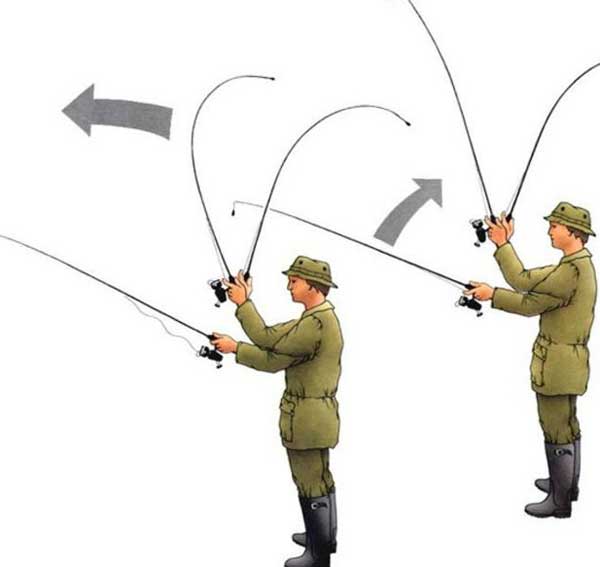
Rating of the best spinning rod models for long-distance casting
Rating of spinning rods for long casting:
- SHIMANO AR-C XX S904MH is perhaps the best spinning rod for long-distance casting, but it is expensive. Made of carbon fiber, made of three sections. Its characteristics: test - 15-60 g, stick length - 2.85 m, fast action, weight - 240 g.
- Norstream Kando 962H has the longest length in the series - 2.89 m. It is intended exclusively for long-distance tackle throws. It is used in combination with various baits, has a test weight of 12-45 g. It performs better when jigging from the shore, due to its high sensitivity and power. Often used on asp.
- Daiko Absolute 1002MHXF is an expensive rod for coastal jigging. It is used by most expert fishermen who hunt for fish at ultra-long distances. The length is 3.05 m, and the test is 10.5-42 g. It is durable and sensitive at the same time. It transmits even light bites and allows for instant hooking. It dampens prey jerks well.
With the right long-range tackle and suitable equipment, it will be possible to catch many trophy fish that live at a distance from the shore. One of the factors in a fisherman’s experience is the casting distance of the tackle, so it’s worth starting to develop skills from the beginning of your fishing career.
Originally posted 2018-09-12 10:34:20.

